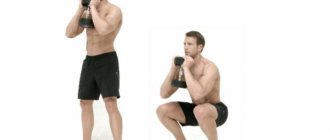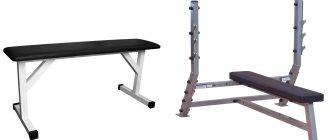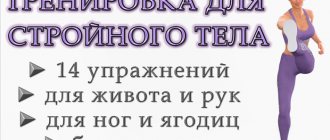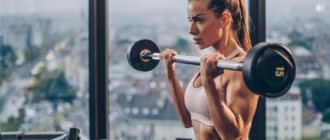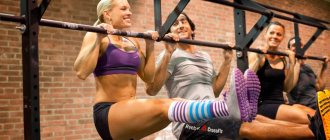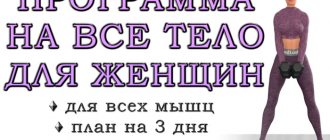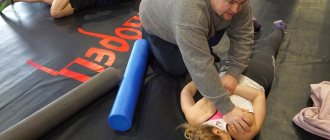To create an ideal body, it is not at all necessary to visit an elite fitness center with expensive equipment. All you need are dumbbells and the desire to take action!
A subscription to a cool fitness center sometimes costs a decent amount, but it is by no means a guarantee that you will achieve ideal results. Many people don’t even realize that some goals are quite achievable outside the walls of the gym.
At home, on the street or in the country - you can exercise anywhere, thanks to universal equipment, namely dumbbells. If you are more interested in the basics or analysis of exercises with dumbbells for girls, you should first understand the basics.
Breast
Strengthening the pectoral muscle requires 3 things: concentration, control and contraction. You need to concentrate and know which muscles work in the exercise. Control means that you monitor the movements and speed of the exercises. The slower you perform them, the more you load the muscle fibers. A slow pace also reduces the risk of injury. When you focus your attention on the muscles being trained, the effectiveness of the exercise increases.
Dumbbell Bench Press
A great exercise for chest training. It can be performed on a flat, incline, or negative incline bench. This way you can shift the load to the middle, top, or bottom of the pectoral muscles. Try to lower the weight slowly so that you feel the same muscle tension as when lifting the weight. If you lift dumbbells too quickly, you risk shoulder injury. It is also important to choose the appropriate dumbbell weight. The resistance should be enough so that you can feel your pectoral muscles working.
More information…
Dumbbell curls
An excellent exercise for developing the pectoral muscles. Its value lies in the fact that it makes it possible to exclude all auxiliary muscles from work and the load on the chest will be concentrated. Dumbbell curls can be performed on a horizontal bench, an incline bench, or a bench with a negative incline. This will allow you to better work on different areas of the chest. To perform the exercise, take dumbbells and lie down on a bench. The shoulder blades are retracted. There is a deflection in the lower back. The legs rest firmly on the floor. Hold dumbbells at arm's length above your chest, palms facing each other. As you inhale, begin to spread your arms to the sides, slightly bending them at the elbows. As you exhale, bring your arms together, returning to the starting position.
More information…
Pullover with dumbbell
With this exercise you can increase the volume of the chest. To perform it, lie with your back on a bench. The legs rest firmly on the floor. Hold the dumbbell in front of you with your arms outstretched. As you inhale, lower the dumbbell behind your head (at the final phase of the movement, you can bend your elbows slightly). As you exhale, return to the starting position.
More information…
Training with dumbbells at home
Our goal is a minimum of equipment and maximum results in the formation of muscle mass. With this program you can work your entire body and create a foundation for further development.
Even if you already use machines or barbells in your training, this dumbbell workout can shock your muscles.
Back
In everyday life, we use the muscles of the front part of the body more, so the back muscles are often underdeveloped, which leads to stooping. Your goal is to develop your entire body evenly. The exercises we offer with dumbbells will help you with this.
Bent-over dumbbell row
The bent over dumbbell row is a great core exercise for developing your core and upper back. When performing this exercise, a special stand is used, which makes it possible to completely turn off the lower back from work to avoid injury. The value of the exercise is that it can help correct back imbalances. To perform it, do the following: place your left knee on the bench. Then bend over and place your hand on it. The body is almost parallel to the floor. There is a deflection in the lower back. The right foot is on the floor. With your right hand, hold the dumbbell with a neutral grip. As you exhale, pull the dumbbell to your lower abdomen by contracting your back muscles. As you inhale, slowly lower the dumbbell to the starting position. Repeat the exercise on the other side.
More information…
Incline dumbbell row
This is an exercise to work your back muscles. The latissimus muscles receive the main load here. The main advantage of this exercise is that when it is performed, the load is removed from the lower back. Therefore, this exercise is suitable for people who cannot load their lower back. To perform it, take the weights and lie face down on an incline bench. Hold dumbbells with a neutral grip, with your arms straight at the sides of the bench. As you exhale, lift the dumbbells by bending your elbows. As you inhale, lower the dumbbells to the starting position.
More information…
Shrugs with dumbbells
Shrugs are an exercise that is aimed at training the trapezius muscle. Shrugs are performed with both dumbbells and a barbell. The advantage of dumbbells is that the movement of the exercise becomes more natural and the amplitude of the exercise increases. To perform it, take dumbbells in your hands and stand straight. Stretch your arms at your sides. As you exhale, pull your shoulders up as high as you can. Hold this position for a second and return to the starting position.
More information…
Aspects to know before you start training
The set of muscles located in the back area is the largest muscle group of the entire human body. Pumped trapezius muscles give your figure power, and the latissimus muscles will make your shoulders wider. It is important to remember that back exercises, which are performed in the gym in order to pump up this part of the body, are very traumatic. And if the load is given incorrectly, that is, very large at once, then there is a high risk of injuring the back and provoking the development of a number of pathologies.
If you exercise incorrectly, you can injure your back.
Attention! Incorrectly dosed load on the back muscles can cause the development of osteochondrosis, intervertebral hernias, etc.
That’s why you shouldn’t rush right off the bat – you need to load your muscles gradually, starting with the simplest basic exercises. This is especially true for those people who until some time were far from sports and led a sedentary lifestyle.
Back exercises
As for people who are not trying to pump up their back, but simply want to improve their physical fitness a little, then for them the load at first should be dosed. For those who already have a number of problems with the spine, it is better to consult a doctor about the possibility of playing sports. In the latter case, it is still better to exclude serious strength exercises and focus on physical therapy or back stretching. These types of physical activity can also improve the condition of your back, but will not aggravate the current situation.
Prices for back belts
Legs and buttocks
Although exercises with a barbell are considered the most effective for the muscles of the legs and buttocks (due to the possibility of using large weights), nevertheless, with the help of dumbbells you can also work out these muscle groups quite well. To achieve what you want, the main thing is to do the exercises correctly. All movements must be clear and precise. And as a result, in addition to impressive external results, you will get strong legs and buttocks, which will allow you to significantly improve your performance in other sports, such as running and jumping.
Straight-legged row with dumbbells
In this exercise, the muscles of the buttocks, back of the thigh and lower back receive the greatest load. During dumbbell rows, the hands are in a more comfortable position than a fixed barbell. Thanks to this position of the hands, you can shift the center of gravity, due to which the load on the back extensors is reduced and the load on the back of the thigh is more concentrated. To perform this exercise, grab dumbbells and stand straight. Place your feet shoulder-width apart. As you inhale, moving your pelvis back and leaning forward, smoothly lower the dumbbells down. As you exhale, return to the starting position.
More information…
Squats with dumbbells
Squats are a basic exercise for strengthening the muscles of the front and back of the thighs and buttocks. By doing it, you also use the muscles of the inner and outer thighs. To perform this exercise, hold dumbbells in your hands and stand straight. Feet shoulder-width apart, toes slightly pointed to the sides. Hands with dumbbells are lowered along the body, palms facing inward. Keeping your pelvis in a neutral position, expand your chest. Inhale, hold your breath and draw in your stomach. Do a squat as if you want to sit on the edge of a chair. Don't lift your heels off the floor. Lower yourself until your thighs are parallel to the floor. Return to the starting position. At the moment of maximum effort, exhale.
More information…
Lunges with dumbbells
Lunges with dumbbells are one of the best exercises for training your legs and buttocks. In this exercise, the hamstrings and gluteal muscles receive maximum load. To perform it, take dumbbells in your hands and stand straight. Feet shoulder width apart. Bring your shoulder blades together, lower your shoulders, tighten your abs. Hands with dumbbells are lowered along the body, palms facing inward. Take a long step forward with your left foot and lower into a lunge so that your left knee is over your ankle and your right knee is pointing toward the floor. The right leg rests on the toe. Straighten your legs and take a step forward and lunge with your right leg. Continue alternating legs as many times as necessary.
More information…
Gluteal leads
- Take a half-sitting position on the floor (stand on your palms and knees).
- Place a dumbbell in one of the popliteal fossae and squeeze it.
- Maintaining the starting position, while exhaling, move the bent leg off the dumbbells to the side, with the knee joint up.
- At the top point, try to additionally squeeze the buttock beyond the contraction. You can take an additional pause in this position.
- As you inhale, return your leg to the starting position and as you exhale, repeat the movement again.
- 4 sets of 10 reps with each leg.
Biceps
As with any strength exercise, proper technique and concentration are very important when training biceps with dumbbells. Also try to avoid common mistakes when doing exercises for the biceps muscles. For example, many people do not fix their shoulders and body in a stationary position, which takes some of the load off the biceps. Only the muscles supporting the elbow joint should work, while the shoulders, wrists and body remain motionless.
Dumbbell Curls
Dumbbell curls are one of the best exercises to train your biceps. The advantage of dumbbells over a barbell is the increased amplitude of wrist rotation, which provides better training of the biceps muscle. This exercise can be performed standing or sitting on a vertical or inclined bench. To perform it, take dumbbells and stand straight (or sit on a bench). The elbows are pressed to the sides of the body and remain motionless throughout the entire movement. As you exhale, bend your elbows. As you inhale, straighten your arms to return to the starting position.
More information…
Hammer grip dumbbell curls
The hammer is an isolation exercise aimed at developing the brachialis muscle, the muscle that is located under the biceps and which gives it the peak that all athletes desire. Perform the exercise standing or sitting on a bench. To do this, take dumbbells with a neutral grip and stand straight or sit on a bench. The arms are extended to the sides of the body. As you exhale, lift the dumbbells to shoulder level. As you inhale, lower the dumbbells back to the starting position.
More information…
Concentration lift with dumbbell
The peculiarity of this exercise is the large range of motion and powerful peak contraction at the top point. The biceps receive the maximum load in this exercise. To perform the exercise correctly, sit on a bench and place your feet slightly wider than shoulder-width apart. Take a dumbbell, bend over slightly and rest your right elbow on the inside of your right leg. As you exhale, lift the dumbbell to your upper chest. As you inhale, return to the starting position. Perform the required number of times and repeat the exercise for the other hand.
More information…
Scott Bench Dumbbell Curls
The Scott Bench Dumbbell Curl is an exercise for targeted biceps training. The advantage of this exercise is that it eliminates the use of cheating, so the biceps brachii muscle receives maximum load. To perform it, sit on a Scott bench and hold dumbbells in both hands, palms facing up. You can also hold dumbbells with a hammer grip (palms facing each other) to work the brachialis muscle. As you exhale, straining your biceps, bend your arms as much as possible, raising the dumbbells to your shoulder. As you inhale, lower the dumbbells.
More information…
Arm muscles - anatomical atlas
Muscles are elastic fibers, thanks to which the arms can rotate, extend, bend, they can be moved away from the body or, on the contrary, brought towards the body.
The arm muscles respond well to training and quickly become stronger
Two large groups can be distinguished:
- from shoulder to elbow - brachial muscles
- from the elbow to the hand - muscles of the forearm
In addition, muscles can be superficial, that is, located under the skin, or deep, they are located under the superficial muscles, on the bones.
During training, we are most interested in the superficial muscles of the shoulder: biceps (or biceps), triceps (or triceps) and deltoids. They occupy a large area of the shoulders and increase in volume well through exercise.
Triceps
When you train triceps, like any other muscle group, you need to use a variety of equipment, including dumbbells, to vary the load as much as possible. Try to feel the triceps working and always pay attention to your technique. Don't forget that when you focus on how your muscles are working during a workout, you will recruit more muscle fibers. Therefore, each repetition and approach is more effective, and you get the desired results much faster.
French press with dumbbells
The French press is a unique exercise for training the triceps. This exercise allows you to work the triceps along its entire length. When performing this exercise, the emphasis is on the load on the long head of the triceps. This exercise can be performed lying down or sitting. We suggest considering the option of performing the French bench press. Lie down on a bench and grab dumbbells with your palms facing each other. As you inhale, bend your arms and lower the dumbbells to your ears. As you exhale, extend your arms at the elbows, returning to the starting position.
More information…
Bent over arm extension with dumbbell
Another exercise with dumbbells to pump up the triceps. This exercise cannot be called the best for training the triceps, but doing it will diversify your arm training, which will undoubtedly benefit you. It is performed as follows: take a dumbbell in your right hand and rest your left knee on the seat of the bench. Also rest your left hand on the back or seat of the bench. Bend your working arm at a right angle - this will be your starting position. Now straighten your arm at the elbow until it is completely straight, hold for a split second and return to the starting position. Perform the required number of times and repeat the exercise for the second hand.
Who is this program for?
This program is best suited for beginner athletes: there are no complex movements, and the technique of most exercises is easy to master. The program includes exercises for all key muscle groups, both isolation and compound compound exercises, which can work to increase testosterone and growth hormone levels.
The program can also be used by advanced athletes who temporarily cannot afford to go to the gym. Outside the gym, it will help not only maintain, but also gain muscle. The latter can be achieved by progressing in working weights and using advanced techniques - for example, drop sets or forced reps.
Shoulders
In most deltoid exercises, you hold the dumbbells farther away from your body, so they feel heavier than the barbell. Therefore, in order to properly work out the muscles, start training with not very heavy dumbbells. The exercises below will improve your shoulder shape by developing and strengthening your deltoid muscles.
Dumbbell Overhead Press
This exercise strengthens the middle and anterior deltoid muscles. To perform this, set the back of the bench at a right angle. Take dumbbells and sit down. Knees bent, feet flat on the floor. Bend your arms at a 90-degree angle and spread them to the sides so that your shoulders are parallel to the floor. Palms face forward. Tighten your abs. The back is straight, the lower back is pressed tightly against the back of the bench. Maintaining your torso position, raise your arms with the dumbbells above your head. Slowly return to the starting position.
More information…
Arnold press
The Arnold press is a basic exercise for developing the deltoid muscles. This exercise uses all three bundles, but the main emphasis is on the middle and anterior bundle. Due to the rotation of the arms, the rotator cuff muscles are also included in the work: coracobrachialis, supraspinatus and infraspinatus. The technique for performing this exercise is as follows: stand up straight or sit on a bench. Take dumbbells in both hands and fix them at neck level, with your palms facing you. Inhale and, holding your breath, press the dumbbells upward while rotating your arms at the wrists. At the end of the movement, exhale. Inhale and lower the dumbbells along the same path.
More information…
Bent-over dumbbell raises
Bent-over dumbbell flyes are the most effective exercise for the posterior deltoid muscle. This exercise is the only one that allows you to qualitatively work out the rear head of the delta. To perform it, take dumbbells and lean forward, bending your knees slightly. Hands with dumbbells are lowered down. As you exhale, simultaneously spread your arms to the sides. As you inhale, lower your arms to the starting position.
More information…
Dumbbell lateral raises
This is an isolation exercise for working the middle fascicles of the deltoid muscles. You can do it standing or sitting on a bench. To do this, hold the dumbbells with a neutral grip, palms facing each other. Stand up straight or sit on a bench. The arms are slightly bent at the elbows. As you exhale, spread the dumbbells to the sides without changing the angle of your elbows. As you inhale, lower your arms to the starting position.
More information…
Exercises for mastering the technique of skating skiing
It seems to me that for more or less effective skating, you need, firstly, to have normal ski equipment, and secondly, to skate at least two ski seasons while constantly improving your technique. It’s clear that in terms of equipment you must have special skis and ski boots for skating.
Less important, but also important, are light poles. With aluminum ones, as I realized today, mastering the technique will be more difficult, because with heavy poles the technique itself changes (today I rode with carbon poles for the first time and it was great). However, I want to warn beginners - get ready that skating for the first season will cause you a lot of inconvenience; mastering the technique takes a lot of time and mental effort.
But then you will enjoy the ride. Although I started skiing only 3 years ago, skiing itself has always given me some kind of indescribable pleasure and joy. I mean, to get a dose of joy, I just need to watch the broadcast on TV, watching a skier skate.
This collection of videos is intended primarily for amateurs who are starting to master skating techniques. For those who already know how to skate, we can recommend skiing without poles. This allows the muscles to work better, and the feeling of movement improves.
Although it is important to note that the technique of skating without poles and with poles has completely different sensations. The legs and body still work differently, which can be seen in the following videos. I would also like to note that the videos may be useful for those who are trying to master the technique of climbing uphill (alternating multi-time moves) on a new hand.
So, for example, I am good at this technique when using the right hand, but absolutely terrible when focusing on the left. And the point here is not the difference in the strength of the muscles in my arms, but in my head - the correct motor skills have not been developed (I’m not sure what the phenomenon of left-handers and right-handers has to do with this).
By the way, I note that not all exercises are aimed at strengthening useful skills. Some allow you to feel what not to do.
So, video. Unfortunately, the video is in English, so I will translate the key points into Russian.
